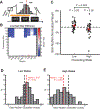Direct Brain Stimulation Modulates Encoding States and Memory Performance in Humans
- PMID: 28434860
- PMCID: PMC8506915
- DOI: 10.1016/j.cub.2017.03.028
Direct Brain Stimulation Modulates Encoding States and Memory Performance in Humans
Abstract
People often forget information because they fail to effectively encode it. Here, we test the hypothesis that targeted electrical stimulation can modulate neural encoding states and subsequent memory outcomes. Using recordings from neurosurgical epilepsy patients with intracranially implanted electrodes, we trained multivariate classifiers to discriminate spectral activity during learning that predicted remembering from forgetting, then decoded neural activity in later sessions in which we applied stimulation during learning. Stimulation increased encoding-state estimates and recall if delivered when the classifier indicated low encoding efficiency but had the reverse effect if stimulation was delivered when the classifier indicated high encoding efficiency. Higher encoding-state estimates from stimulation were associated with greater evidence of neural activity linked to contextual memory encoding. In identifying the conditions under which stimulation modulates memory, the data suggest strategies for therapeutically treating memory dysfunction.
Keywords: deep brain stimulation; epilepsy; episodic memory; free recall; intracranial EEG; local field potential; multivariate classification.
Copyright © 2017 Elsevier Ltd. All rights reserved.
Figures





Comment in
-
Human Memory: Brain-State-Dependent Effects of Stimulation.Curr Biol. 2017 May 22;27(10):R385-R387. doi: 10.1016/j.cub.2017.03.079. Curr Biol. 2017. PMID: 28535389
Similar articles
-
Event-related brain potentials in memory: correlates of episodic, semantic and implicit memory.Clin Neurophysiol. 2003 Jun;114(6):1144-52. doi: 10.1016/s1388-2457(03)00044-0. Clin Neurophysiol. 2003. PMID: 12804683
-
Comparison of logistic regression, support vector machines, and deep learning classifiers for predicting memory encoding success using human intracranial EEG recordings.J Neural Eng. 2018 Dec;15(6):066028. doi: 10.1088/1741-2552/aae131. Epub 2018 Sep 13. J Neural Eng. 2018. PMID: 30211695 Free PMC article.
-
Subsequent memory effect in intracranial and scalp EEG.Neuroimage. 2014 Jan 1;84:488-94. doi: 10.1016/j.neuroimage.2013.08.052. Epub 2013 Sep 6. Neuroimage. 2014. PMID: 24012858 Free PMC article.
-
Direct electrical brain stimulation of human memory: lessons learnt and future perspectives.Brain. 2023 Jun 1;146(6):2214-2226. doi: 10.1093/brain/awac435. Brain. 2023. PMID: 36408731 Review.
-
Direct brain recordings fuel advances in cognitive electrophysiology.Trends Cogn Sci. 2010 Apr;14(4):162-71. doi: 10.1016/j.tics.2010.01.005. Epub 2010 Feb 25. Trends Cogn Sci. 2010. PMID: 20189441 Free PMC article. Review.
Cited by
-
The Neurostimulationist will see you now: prescribing direct electrical stimulation therapies for the human brain in epilepsy and beyond.Front Hum Neurosci. 2024 Sep 4;18:1439541. doi: 10.3389/fnhum.2024.1439541. eCollection 2024. Front Hum Neurosci. 2024. PMID: 39296917 Free PMC article. Review.
-
Developing a hippocampal neural prosthetic to facilitate human memory encoding and recall of stimulus features and categories.Front Comput Neurosci. 2024 Feb 8;18:1263311. doi: 10.3389/fncom.2024.1263311. eCollection 2024. Front Comput Neurosci. 2024. PMID: 38390007 Free PMC article.
-
Decoding task engagement from distributed network electrophysiology in humans.J Neural Eng. 2019 Aug 16;16(5):056015. doi: 10.1088/1741-2552/ab2c58. J Neural Eng. 2019. PMID: 31419211 Free PMC article.
-
Unsupervised machine-learning classification of electrophysiologically active electrodes during human cognitive task performance.Sci Rep. 2019 Nov 22;9(1):17390. doi: 10.1038/s41598-019-53925-5. Sci Rep. 2019. PMID: 31758077 Free PMC article.
-
Causal roles of prefrontal cortex during spontaneous perceptual switching are determined by brain state dynamics.Elife. 2021 Oct 29;10:e69079. doi: 10.7554/eLife.69079. Elife. 2021. PMID: 34713803 Free PMC article.
References
MeSH terms
Grants and funding
LinkOut - more resources
Full Text Sources
Other Literature Sources
Medical

